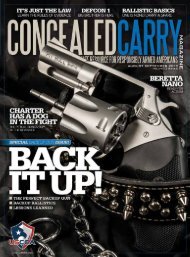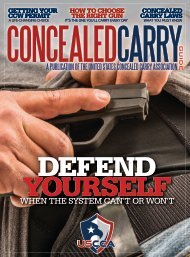You also want an ePaper? Increase the reach of your titles
YUMPU automatically turns print PDFs into web optimized ePapers that Google loves.
Drill #1: Set up a standard combat/humanoid target at five meters. Make asmall aiming point on it, such as a crossor a dot (about an inch in size). Bringyour pistol up to the point position andfire a group of five shots without takingthe focus of your vision or your attentionoff of the front sight. Strive to place themall in the same hole, or at least touchingeach other. Shoot slowly for accuracyonly. When five meters is no longerchallenging, move to seven, and so on.Strive for as small of a group as possible,and do not fire until every aspect of thesight picture and trigger press is perfect.Drill #2: Follow the same procedureas the previous drill, but begin in theready position. Move from ready topoint quickly, and then carefully (withoutrushing) fire a single, perfect shot.Drill #3: Use the same procedureas the first drill, but begin with the pistolholstered. Remember, perfect shots only.Your group should be approximatelythe same size as in the two previousexercises.Drill #4: Use the same procedureas drill #3, but fire two controlled shots.Press the trigger for the first shot. Holdthe trigger to the rear on recoil and donot release it until you obtain a secondsight picture. Now release it only as farSpeed of draw is essential to survival in areactive gunfighting environment.as necessary to reset it for a secondshot and again focusing visually on thetop edge of the front sight, press for thesecond perfect shot.Once you can fire extremely accurateshots on demand, begin to include anincreasingly shorter time interval. <strong>This</strong>begins to blend into the chapter on speeddevelopment. Your goal as a student ofthe pistol is to find your personal balancebetween speed and accuracy. That jobbelongs to all of us, doesn’t it?Reading your targets: It is sometimesdifficult to gauge your performance atthe firing range because of the noise andtumult associated with a live-fire drill. Itis helpful if you look at your target as a“final exam” paper. It will tell you thingsabout your grip, stance, trigger press andso forth...if you know how to read it. Lookat where your shots have hit. Assumingthat your pistol is properly sighted in, anyvariance from a center hit is all you.1) Shots Low: If you find that yourshots are low on the target, it is a signthat you are not pressing the triggercarefully. Sometimes shooters will anticipatethe shot and hurry the triggerpress abruptly (a.k.a. “jerk”). They mayeven reflexively force the muzzle downslightly in anticipation of the shot. In turn,this causes the front sight to dip low andeither to the left or the right as the bulletleaves the barrel.The training solution to this is topractice the “ball and dummy” drill.<strong>This</strong> drill is extremely useful, and I makeit an ongoing part of my training. Fill amagazine with 2/3 dummy (inert) roundsand 1/3 live cartridges. Now carry onwith your training. Mentally convinceyourself that the pistol is completelyloaded with dummy rounds. The bulkof the trigger presses will bear this out.Eventually, however, you will experiencea live round being fired (and get a realsurprise break). Prolonged use of thisdrill will desensitize you to the reportand noise of the shot and will curethe problem.2) Shots right or left: If your shots areconsistently hitting the target to the right ofthe paper, you probably have too muchtrigger finger on the trigger. The result isthat when you press to the rear, you arealso pulling to the right. You may thinkthat everything is perfect, but the paperwill not verify your “feeling.” If your shotsare hitting too far to the left, invariablyyou are not placing enough trigger fingeron the trigger, and you are causing theopposite of the previous situation. Notethat a left-handed shooter will reversethese circumstances.3) Shots high: <strong>This</strong> is most oftencaused by not focusing intently enoughon the front sight, and instead looking upat the target at the final moment. It is alsocaused by not “stopping” on the targetduring a presentation and instead tryingto “ambush” the target as you pass it.The solution is to maintain visualfocus on the front sight as the shot isfired. In fact, look for the front sight liftingoff of the target on recoil. Additionally,be certain that you have in fact stoppedmoving before the final pressure isexerted on the trigger.Gabriel Suarez is an internationallyrecognized trainer and lecturerin the field of civilian personaldefense. He has written over adozen books and taught courses inseveral countries.http://www.suarezinternational.comhttp://www.warriortalk.comSuarez International, Inc.303 E. Gurley St., Ste. 461Prescott, AZ 86301 <strong>US</strong>A(Office) 928-776-4492Volume 4 - May/June 2007 www.usconcealedcarry.com<strong>Concealed</strong> <strong>Carry</strong> Magazine 35
















